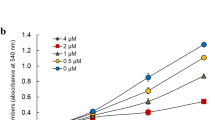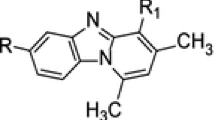Abstract
Background
Head and neck cancer is the sixth most frequently occurring cancer worldwide and accounts for about 2 % of all cancer-related deaths annually. Curcumin is a well-known chemopreventive agent, and apoptosis induction by curcumin has been reported in many cancer cell types. We synthesized an ortho-hydroxy substituted analog of curcumin, bisdemethoxycurcumin analog (BDMC-A), and aimed to demarcate the apoptotic effects induced by BDMC-A on human laryngeal cancer Hep-2 cells and to compare these effects with those induced by curcumin.
Methods
We evaluated the apoptotic effects of BDMC-A in comparison to those of curcumin on Hep-2 cells by performing Western blotting, RT-PCR, fluorescent staining and DNA fragmentation assays. In addition, we carried out an in silico molecular docking study on the EGFR kinase domain.
Results
We found that BDMC-A can induce apoptosis in Hep-2 cells by regulating the expression of both intrinsic and extrinsic apoptotic proteins, i.e., Bcl-2, Bax, apoptososme complex and death receptors, more efficiently than curcumin. We also observed increased nuclear fragmentation and chromatin condensation after BDMC-A treatment compared to curcumin treatment. Depolarized mitochondria and ROS generation was well pronounced in both BDMC-A and curcumin treated Hep-2 cells. Our in silico molecular docking study on the EGFR kinase domain revealed that BDMC-A may dock more efficiently than curcumin.
Conclusions
From our results we conclude that BDMC-A can induce apoptosis in Hep-2 laryngeal carcinoma cells more effectively than curcumin, and that this activity can be attributed to the presence of a hydroxyl group at the ortho position within this compound.









Similar content being viewed by others
References
S. Ghosh, A. Ghosh, G.P. Maiti, N. Alam, A. Roy, B. Roy, S. Roychoudhury, C.K. Panda, Alterations of 3p21.31 tumor suppressor genes in head and neck squamous cell carcinoma: correlation with progression and prognosis. Int. J. Cancer 123, 2594–2604 (2008)
C. Salazar, R. Nagadia, P. Pandit, J. Cooper-White, N. Banerjee, N. Dimitrova, W.B. Coman, C. Punyadeera, A novel saliva-based microRNA biomarker panel to detect head and neck cancers. Cell. Oncol. 37, 331–338 (2014)
T. Nakaoka, A. Ota, T. Ono, S. Karnan, H. Konishi, A. Furuhashi, Y. Ohmura, Y. Yamada, Y. Hosokawa, Y. Kazaoka, Combined arsenic trioxide-cisplatin treatment enhances apoptosis in oral squamous cell carcinoma cells. Cell. Oncol. 37, 119–129 (2014)
D. Weiss, C. Stockmann, K. Schrödter, C. Rudack, Protein expression and promoter methylation of the candidate biomarker TCF21 in head and neck squamous cell carcinoma. Cell. Oncol. 36, 213–224 (2013)
B.B. Aggarwal, C. Sundaram, N. Malani, H. Ichikawa, Curcumin: the Indian solid gold. Adv. Exp. Med. Biol. 595, 1–75 (2007)
S. Shishodia, M.M. Chaturvedi, B.B. Aggarwal, Role of curcumin in cancer therapy. Curr. Probl. Cancer 31, 243–305 (2007)
N. Chakravarti, J.N. Myers, B.B. Aggarwal, Targeting constitutive and interleukin-6-inducible signal transducers and activators of transcription 3 pathway in head and neck squamous cell carcinoma cells by curcumin (diferuloylmethane). Int. J. Cancer 119, 1268–1275 (2006)
A. Chen, J. Xu, A.C. Johnson, Curcumin inhibits human colon cancer cell growth by suppressing gene expression of epidermal growth factor receptor through reducing the activity of the transcription factor Egr-1. Oncogene 25, 278–287 (2006)
S. Prakobwong, J. Khoontawad, P. Yongvanit, C. Pairojkul, Y. Hiraku, P. Sithithaworn, P. Pinlaor, B.B. Aggarwal, S. Pinlaor, Curcumin decreases cholangiocarcinogenesis in hamsters by suppressing inflammation-mediated molecular events related to multistep carcinogenesis. Int. J. Cancer 129, 88–100 (2011)
P. Anand, C. Sundaram, S. Jhurani, A.B. Kunnumakkara, B.B. Aggarwal, Curcumin and cancer: an “old-age” disease with an “age-old” solution. Cancer Lett. 267, 133–164 (2008)
J.M. Davis, E.A. Murphy, M.D. Carmichael, M.R. Zielinski, C.M. Groschwitz, A.S. Brown, J.D. Gangemi, A. Ghaffar, E.P. Mayer, Curcumin effects on inflammation and performance recovery following eccentric exercise-induced muscle damage. Am. J. Physiol. Regul. Integr. Comp. Physiol. 292, 2168–2173 (2007)
B.B. Aggarwal, A. Kumar, A.C. Bharti, Anticancer potential of curcumin: preclinical and clinical studies. Anticancer Res. 23, 363–398 (2003)
J. Nautiyal, S. Banerjee, S.S. Kanwar, Y. Yu, B.B. Patel, F.H. Sarkar, A.P. Majumdar, Curcumin enhances dasatinib-induced inhibition of growth and transformation of colon cancer cells. Int. J. Cancer 128, 951–961 (2011)
R.J. Anto, G. Kuttan, K.V.D. Babu, K.V. Rajasekharan, R. Kuttan, Anti-tumour and free radical scavenging activity of synthetic curcuminoids. Inter. J. Pharm. 131, 1–7 (1996)
R.J. Anto, J. George, K.V. Babu, K.N. Rajasekharan, R. Kuttan, Antimutagenic and anticarcinogenic activity of natural and synthetic curcuminoid. Mutat. Res. 370, 127–131 (1996)
R. Rukkumani, K. Aruna, P.S. Varma, K.N. Rajasekaran, V.P. Menon, Comparative effects of curcumin and an analog of curcumin on alcohol and PUFA induced oxidative stress. J. Pharm. Pharm. Sci. 7, 274–283 (2004)
R. Rukkumani, K. Aruna, P.S. Varma, P. Viswanathan, K.N. Rajasekaran, V.P. Menon, Protective role of a novel curcuminoid on alcohol and PUFA-induced hyperlipidemia. Toxicol. Mech. Methods 15, 227–234 (2005)
R. Rajagopalan, S. Sridharan, V.P. Menon, Hepatoprotective role of bis-demethoxy curcumin analog on the expression of matrix metalloproteinase induced by alcohol and polyunsaturated fatty acid in rats. Toxicol. Mech. Methods 20, 252–259 (2010)
T. Devasena, K.N. Rajasekaran, V.P. Menon, Bis-1,7-(2-hydroxyphenyl)-hepta-1,6-diene-3,5-dione (a curcumin analog) ameliorates DMH-induced hepatic oxidative stress during colon carcinogenesis. Pharmacol. Res. 46, 39–45 (2002)
M. Kumaravel, P. Sankar, P. Latha, C.S. Benson, R. Rukkumani, Antiproliferative effects of an analog of curcumin in Hep-2 cells: a comparative study with curcumin. Nat. Prod. Commun. 8, 183–186 (2013)
K.Y. Chang, S.Y. Tsai, S.H. Chen, H.H. Tsou, C.J. Yen, K.J. Liu, H.L. Fang, H.C. Wu, B.F. Chuang, S.W. Chou, C.K. Tang, S.Y. Liu, P.J. Lu, C.Y. Yen, J.Y. Chang, Dissecting the EGFR-PI3K-AKT pathway in oral cancer highlights the role of the EGFR variant III and its clinical relevance. J. Biomed. Sci. 20, 43 (2013)
S. Haupt, M. Berger, Z. Goldberg, Y. Haupt, Apoptosis - the p53 network. J. Cell Sci. 116, 4077–4085 (2003)
G. Sa, T. Das, Anti cancer effects of curcumin: cycle of life and death. Cell Div. 3, 14 (2008)
C. Gajate, F. Mollinedo, Cytoskeleton-mediated death receptor and ligand concentration in lipid rafts forms apoptosis-promoting clusters in cancer chemotherapy. J. Biol. Chem. 280, 11641–11647 (2005)
H.F. Lu, K.C. Lai, S.C. Hsu, H.J. Lin, M.D. Yang, Y.L. Chen, M.J. Fan, J.S. Yang, P.Y. Cheng, C.L. Kuo, J.G. Chung, Curcumin induces apoptosis through FAS and FADD, in caspase-3-dependent and -independent pathways in the N18 mouse-rat hybrid retina ganglion cells. Oncol. Rep. 22, 97–104 (2009)
S. Shankar, R.K. Srivastava, Bax and Bak genes are essential for maximum apoptotic response by curcumin, a polyphenolic compound and cancer chemopreventive agent derived from turmeric, Curcuma longa. Carcinog. 28, 1277–1286 (2007)
M. Roy, S. Chakraborty, M. Siddiqi, R.K. Bhattacharya, Induction of Apoptosis in Tumor Cells by Natural Phenolic Compounds. Asian Pac. J. Cancer Prev. 3, 61–67 (2002)
K.V. Dinesh Babu, K.N. Rajasekaran, Simplified conditions for the synthesis of curcumin I and other curcuminoids. Org. Prep. Proc. Int. 24, 674–677 (1994)
R.J. Fido, A.S. Tatham, P.R. Shewry, Western blotting analysis, in Methods in molecular biology: plant gene transfer and expression protocols, ed. by H. Jones, vol. 49 (Humana Press Inc, Totowa, 1995), pp. 423–437
P. Chomczynski, N. Sacchi, Single-step method of RNA isolation by acid guanidinium thiocyanate-phenol-chloroform extraction. Anal. Biochem. 162, 156–159 (1987)
C. Brana, C. Benham, L. Sundstrom, A method for characterising cell death in vitro by combining propidium iodide staining with immunohistochemistry. Brain Res. Brain Res. Protoc. 10, 109–114 (2002)
R.A. Friesner, R.B. Murphy, M.P. Repasky, L.L. Frye, J.R. Greenwood, T.A. Halgren, P.C. Sanschagrin, D.T. Mainz, Extra precision glide: docking and scoring incorporating a model of hydrophobic enclosure for protein-ligand complexes. J. Med. Chem. 4, 6177–6196 (2006)
D. Hanahan, R.A. Weinberg, Hallmarks of cancer: the next generation. Cell 144, 646–674 (2011)
C. Ramachandran, S. Rodriguez, R. Ramachandran, P.K. Raveendran Nair, H. Fonseca, Z. Khatib, E. Escalon, S.J. Melnick, Expression profiles of apoptotic genes induced by curcumin in human breast cancer and mammary epithelial cell lines. Anticancer Res. 25, 3293–3302 (2005)
S.W. Lowe, E. Cepero, G. Evan, Intrinsic tumour suppression. Nature 432, 307–315 (2004)
T. Miyashita, J.C. Reed, Tumor suppressor p53 is a direct transcriptional activator of the human bax gene. Cell 80, 293–299 (1995)
S. Awantika, K. Durga Prasad, G. Archana, In Silico molecular docking analysis to identify PI3K inhibitors as possible NSCLC agents. Int. J. Comput. Bioinfo. In Silico Model 2, 68–71 (2013)
U.M. Moll, O. Petrenko, The MDM2-p53 interaction. Mol. Cancer Res. 1, 1001–1008 (2003)
R. Wilken, M.S. Veena, M.B. Wang, E.S. Srivatsan, Curcumin: a review of anti-cancer properties and therapeutic activity in head and neck squamous cell carcinoma. Mol. Cancer 10, 12 (2011)
S. Shankar, Q. Chen, K. Sarva, I. Siddiqui, R.K. Srivastava, Curcumin enhances the apoptosis-inducing potential of TRAIL in prostate cancer cells: molecular mechanisms of apoptosis, migration and angiogenesis. J. Mol. Signal. 2, 10 (2007)
R.U. Janicke, M.L. Sprengart, M.R. Wati, A.G. Porter, Caspase-3 is required for DNA fragmentation and morphological changes associated with apoptosis. J. Biol. Chem. 273, 9357–9360 (1998)
H.Y. Chang, X. Yang, Proteases for cell suicide: functions and regulation of caspases. Microbiol. Mol. Biol. Rev. 64, 821–846 (2000)
R. Prasanna, C.C. Harish, R. Pichai, D. Sakthisekaran, P. Gunasekaran, Anti-cancer effect of Cassia auriculata leaf extract in vitro through cell cycle arrest and induction of apoptosis in human breast and larynx cancer cell lines. Cell Biol. Int. 33, 127–134 (2009)
C.B. Gonzales, N.B. Kirma, J.J. De La Chapa, R. Chen, M.A. Henry, S. Luo, K.M. Hargreaves, Vanilloids induce oral cancer apoptosis independent of TRPV1. Oral Oncol. 50, 437–447 (2014)
D. Wang, J. Hu, L. Lv, X. Xia, J. Liu, X. Li, Enhanced inhibitory effect of curcumin via reactive oxygen species generation in human nasopharyngeal carcinoma cells following purple-light irradiation. Oncol. Lett. 6, 81–85 (2013)
A. Shehzad, J. Lee, T.L. Huh, Y.S. Lee, Curcumin induces apoptosis in human colorectal carcinoma (HCT-15) cells by regulating expression of Prp4 and p53. Mol. Cells 35, 526–532 (2013)
T. Atsumi, K. Tonosaki, S. Fujisawa, Induction of early apoptosis and ROS-generation activity in human gingival fibroblasts (HGF) and human submandibular gland carcinoma (HSG) cells treated with curcumin. Arch. Oral Biol. 51, 913–921 (2006)
N. Hasima, B.B. Aggarwal, Cancer-linked targets modulated by curcumin. Int. J. Biochem. Mol. Biol. 3, 328–351 (2012)
S. Shishodia, Molecular mechanisms of curcumin action: gene expression. Biofactors 39, 37–55 (2013)
G.P. Maiti, P. Mondal, N. Mukherjee, A. Ghosh, S. Ghosh, S. Dey, J. Chakrabarty, A. Roy, J. Biswas, S. Roychoudhury, C.K. Panda, Overexpression of EGFR in head and neck squamous cell carcinoma is associated with inactivation of SH3GL2 and CDC25A genes. PLoS One 8, e63440 (2013)
J. Stamos, M.X. Sliwkowski, C. Eigenbrot, Structure of the epidermal growth factor receptor kinase domain alone and in complex with a 4-anilinoquinazoline inhibitor. J. Biol. Chem. 277, 46265–46272 (2002)
R.B. Cohen, Current challenges and clinical investigations of epidermal growth factor receptor (EGFR) - and ErbB family-targeted agents in the treatment of head and neck squamous cell carcinoma (HNSCC). Cancer Treat. Rev. 40, 567–577 (2014)
M.E. Noble, J.A. Endicott, L.N. Johnson, Protein kinase inhibitors: insights into drug design from structure. Science 303, 1800–1805 (2004)
J.J. Liao, Molecular recognition of protein kinase binding pockets for design of potent and selective kinase inhibitors. J. Med. Chem. 50, 409–424 (2007)
Y.H. Peng, H.Y. Shiao, C.H. Tu, P.M. Liu, J.T. Hsu, P.K. Amancha, J.S. Wu, M.S. Coumar, C.H. Chen, S.Y. Wang, W.H. Lin, H.Y. Sun, Y.S. Chao, P.C. Lyu, H.P. Hsieh, S.Y. Wu, Protein kinase inhibitor design by targeting the Asp-Phe-Gly (DFG) motif: the role of the DFG motif in the design of epidermal growth factor receptor inhibitors. J. Med. Chem. 56, 3889–3903 (2013)
Acknowledgments
This work was financially supported by University Grants Commission [F.No 37-309/2009(SR)] and UGC [F.No 41-981/2012 (SR)]. The authors thank DST-FIST, UGC-SAP and DBT -IPLS for providing the infrastructural support. Kumaravel Mohankumar thanks CSIR for providing a senior research fellowship.
Conflict of interest
The authors declare that they have no conflict of interest.
Author information
Authors and Affiliations
Corresponding author
Rights and permissions
About this article
Cite this article
Mohankumar, K., Pajaniradje, S., Sridharan, S. et al. Apoptosis induction by an analog of curcumin (BDMC-A) in human laryngeal carcinoma cells through intrinsic and extrinsic pathways. Cell Oncol. 37, 439–454 (2014). https://doi.org/10.1007/s13402-014-0207-3
Accepted:
Published:
Issue Date:
DOI: https://doi.org/10.1007/s13402-014-0207-3




